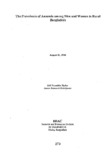The prevalence of Anaemia among men and women in rural Bangladesh
Date
1996-08Publisher
BRAC Research and Evaluation Division (RED)Author
Hyder, SM ZiauddinMetadata
Show full item recordCitation
Hyder, S. Z. (1996, August). The prevalence of Anaemia among men and women in rural Bangladesh. Research Reports (1996): Health Studies, Vol - XlX, 273–291.Abstract
Anaemia is a major public health problem in many developing countries including
Bangladesh. Iron deficiency is known to be the commonest cause of anaemia resulting
from inadequate iron intake, reduced bio-availability of ingested iron, defective
mobilisation of iron reserves, increased needs for iron under certain physiological and
pathological conditions and so on. This study aimed at investigating the prevalence of
anaemia among rural men and women. The survey was conducted in March 1996 in 12
villages of Mymensingh District located about 100 km north of Dhaka city. Eighty four
adult men and 184 adult women aged 15-48 years and 22 adolescent boys and 44
adolescent girls aged 11-14 years were randomly selected. Information was obtained on
haemoglobin concentration, parasitic infestation, literacy and on other household
socioeconomic parametres. It was revealed from the study that mean haemoglobin
concentration of the study population was 114 gIL, and about 69% adult men, 71% adult
women, 68% adolescent boys and 64% adolescent girls were suffering from anaemia
according to the WHO criteria. This study suggests that anaemia is highly prevalent in the
rural communities of Bangladesh which victimises both men and women equally. There is
an urgent need to conduct further studies to confirm if male and female are equally
anaemic to provide important feedback to the existing anaemia control programmes in the
country.

